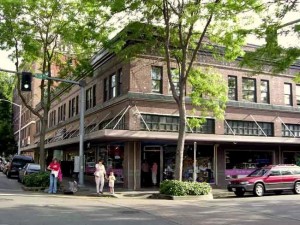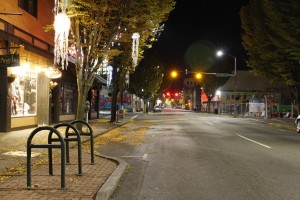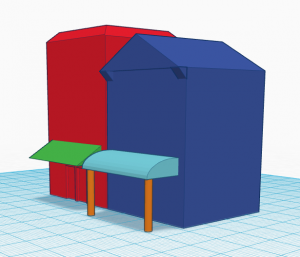H. Forbes Yes Naturally Chapter
Week 10 CST Post
“I think some of them aren’t even physical rides, just virtual flythoughs.” (Doctorow 349)
Virtual seems to be perceived as less real. I can understand this way of looking at it, but I also see how the virtual world is entirely valid and real just as the physical world is. Is a virtual fly-through or view of something less valuable than a walk through of it? Some may argue yes. It’s true, there is something special about experiencing something physical but I don’t think this something special makes the physical more real.
Fourth Blue Rabbit Iteration
My Blue Rabbit idea started out with a focus on cartography and now I think it leans much more towards architecture. As I learned how established and beneficial 3D rendering is to the field of architecture, it drew my attention towards design representation rather than informational representation. I still believe that 3D rendering and printing is absolutely an amazing tool in representing physical concepts/data.
For me personally in my experience with the Blue Rabbit project, I found it difficult to represent something as is. I believe the reason for this is that I am not very good with the software what so ever. With my current level of skill, I would probably be better off drawing from my head and learning what I can do and design rather than stressing over accuracy of map representation. However, I wanted to carry out my original idea. There wasn’t really time to start over and I did still believe in it. I still believe that printing a 3D map of downtown Olympia is important because it will better its viewer’s understanding of the location being represented. Unfortunately I don’t yet have the skill to make an accurate rendering that can be a reference tool, beyond just getting the point of 3D representation across. This is why I feel as though if I could do the Blue Rabbit project over again, I would probably try to design a future home for myself or design a building of some other function. It would be more of a design themed drawing experience than a reporting themed experience.
I have always liked architecture and doodling floor plans for homes. My favorite part of The Sims was making the houses. I’m not particularly creative but designing is something I enjoy doing and something that I see being useful in my future. My dad told me that architecture might not be the best field to go into because when the economy plummets, architects are the first professionals to become unneeded. Apparently when money is tight people no longer feel the need to utilize another’s expertise in their personal designs. It becomes a DIY thing. My response to this was that I don’t want to practice architectural skills because I want to be an architect, I want to practice them so I can successfully “do it myself” when I someday don’t find it necessary to seek professional architectural assistance in building my home or other type of building.
Here is my current 3D rendering of a section of downtown Olympia:
Dimensions: 128.81×132.82×25.04 (mm)
Forbes’ CST post week 9
“I’ve never seen any place designed the way I’d design one. Maybe I’ll do that someday.” (Doctorow 297)
What would happen if everyone designed their own surroundings? Design is something that takes a lot of thought and understanding of the object being designed. Many people feel at some point in time that what’s in front of them is severely flawed and that they could do it better. I believe that a designer’s expertise is essential to functionality and actually bringing something into being, but it is very important for a designer to understand how someone might want to use what they make and how to make it jive with the user. The example in my head while I write this is the “my.evergreen.edu” page. I find it to be far from straight forward or navigable. The only reason I get use out of it now is because I have been instructed in specific ways to use it (which links to click). While becoming familiar with this page I really felt I could have designed a better layout. However, I know nothing about web design, so I believe my input would be most useful alongside an expert, rather than just on its own.
Forbes’ Blue Rabbit Third Iteration
How can someone experience Olympia even without being there?
Olympia is a beautiful city. Unfortunately, it is nearly impossible to see that from an aerial view or a map. To experience the beauty and to feel the vibes of the city it is important to be within it—to be able to view surroundings from many different angles. Capturing Olympia’s essence in photography is a step in the right direction, but imagine viewing the city by means of a 3D physical model. It would be like a miniature Olympia that you can hold in your hands or set up on your desk.
Digital representation can be great. It can document and enhance scenes. I think a digital version of this 3D rendering of Olympia would maybe be more practical. It could be used as an app on a cell phone to be pulled up and used anytime. Especially if the rendering is very realistic and can be moved around in all different angles, it would be just as useful as the physical version, most likely. But I think that it is worth bringing this idea into physical existence because there’s something about being able to touch and move what you’re looking at. I believe people would be more interested in viewing the model for a decent amount of time if it was a physically present model. It wouldn’t necessarily be more useful, and definitely not more practical than the digital version, but I believe it would be more enjoyable and exciting.
Forbes’ week seven reflection
“Most world-dominating plans went sour, while a hefty proportion of modest plans to Make Something Cool actually worked out pretty well, paid the bills, and put food on the table.” (Doctorow 249)
Should we live with intention or just let things happen? How much say do we have in our path? If the ambitious plans to create something significant go “sour”, but tinkering around to just make something cool leads to success and food on the table, how can we trust our intentions will ever be met? According to the above quote, it seems like people have to avoid their goals in order to reach them which doesn’t make sense to me.
Forbes’ week six cst post
“But you can’t put everything under one banner—you can’t just declare to these people that their projects are ours—“ (Doctorow 217)
“Without a corporate entity, it’s like trying to herd cats.” (Doctorow 217)
These quotes make me think back to the documentary we watched in class about the industry of 3D printers and the process in which MakerBot essentially sold out and went from open source to closed source, putting the community’s collective work under MakerBot’s name. Is it true that a community of individuals working for a movement is something that can’t be herded? Do people need a leader in order to work towards something? Perry tried so hard to share his idea with everyone and allow them to work off of it without being under Perry’s rule. But when they faced trouble Perry had to take the leadership position in order to efficiently deal. Is there any way around this?
Hannah Forbes’ Second Blue Rabbit Iteration
“Seeing is Believing”
How do 3D printed models or maps enhance representation?
I believe that 3D representation gets the point of physical objects across best, which is why studying a map that is 3D printed and physically present can help one understand an area better than a flat map image. I came to this idea because the concepts of representation and perspective have always been interesting to me throughout my life. I’m someone who always likes to see things from different angles and I try to contemplate how ideas or data might be better represented and therefore better understood. I’m excited to make a 3D model of at least part of downtown Olympia. Even if I’m the only viewer of it, I know it will better my understanding of the area.
In doing research for this project, I struggled to find sources (that were accessible and understandable to me), which pertained exactly to my idea. It surprised me that it was so difficult to find cartographers interested in 3D mapping, since distortion is such a huge part of 2D mapping. Instead I found examples of my idea demonstrated in Architecture and models of building designs. I came across pages for different companies explaining how 3D printing or 3D rendering/modeling has made a huge difference on the way they do business. Rietveld Architecture Firm perfectly describes why 3D rendering is important for clients’ understanding of designs, and also how 3D printing their designs allows for many more models of various scales and iterations to be made more quickly and efficiently. 3D printing these necessary models also allows for more detail to be incorporated, which provides easier understanding for the viewers.
“During the course of a typical project, Rietveld, like other architecture firms, builds numerous models in increasing detail and scale that help clients to visualize designs. And, like other firms, they had traditionally built these models by hand – a task that usually required two employees to spend upwards of two months cutting, assembling and finishing components made of cardboard, foam board and Plexiglass. The time and expense to hand craft these complex elements dictated that the models have an inadequate amount of detail, limiting the creativity and therefore showcasing a model that sometimes did not sufficiently highlight the selling points of the design.” (Meijs).
Rietveld Architects have been able to take their business a step ahead of their competitors. They say there is always a “wow factor” when they present a 3D printed model. Obviously models are necessary in the architecture industry, in order to examine and appreciate designs. Now 3D printing has brought ease to this very important piece of every project.
Brian Smith and Brian Zajac, founders of 3D Architectural Solutions, are firm believers in the 3D movement and development of the field. They both individually began working on 3D studies in the 90s. While Smith steadily progressed in the field of 3D, Zajac moved to web design, under the impression that work in 3D was not quite worthwhile in those years. Later on he noticed that the world of 3D was quickly picking up actually cost effective (unlike in the 90s) and at this point he and Smith joined to form 3D Architectural Solutions. In 2006 they teamed up with other organizations to form CGschool, which is now the leading company in visualization training.
It is clear that both of these men are very wisely invested in the field of 3D representation. This interest pointed them both in the direction of architecture. The field of architecture is perfect for utilizing expertise in 3D representation, as I talked about before. 3D representation is used for presenting a design most accurately. It is useful to both the designers, and the clients. It is the best way to understand the data in front of you.
“3D Rendering has brought about huge efficiencies in the architectural and engineering industries in recent times. 3D rendering is the process of producing an image based on three-dimensional data stored within a computer.” (The Benefits).
The data used to create these images was already being generated with every design created, but until 3D rendering became a big part of the industry, the only way to understand the design was either by interpreting numerous 2D drawings, depicting different angles, or to use a model which was an expensive, time consuming, detail limiting piece of work… before 3D printing came into the scene.
Representation is key to understanding. In the fields of architecture, mapping, engineering, and others, it is important that people be able to convey their designs, or data they have collected in a manner that makes sense. With anything that exists in three dimensions, the most sensible representation is 3D rendering which is now more than possible but very efficient. I’m excited to create my very own model of the city that is my new home.
Works Cited
“3D Modelization and Visualization.” Open Text. Open Text Corporation, 2011. Web. 02 Nov. 2014.
“The Benefits of 3D Rendering.” AABSys. AABSyS IT, 2014. Web. 02 Nov. 2014.
“Benefits of 3D Rendering and Visualization.” GIS Virtual RSS. GIS Virtual, 08 Aug. 2012. Web. 02 Nov. 2014.
Meijs, Piet. “Examples of 3D Printing in the Architecture Industry.” 3D Printer. Javelin Technologies Inc., 2014. Web. 02 Nov. 2014.
Meijs, Piet. “Objet Technology Enables Architecture Firm to Shave Months Off Model-Building Time.” Case Study. Rietveld Architects LLP, 2010. Web. 2 Nov. 2014.
Smith, Brian, and Brian Zajac. “Why Are 3D Visualization Renderings and Animations Important?” 3D Architectural Solutions. 3DAS LLC, n.d. Web. 01 Nov. 2014.
“The Societal Impacts of 3D Printing.” 3D Printing. WordPress.com, n.d. Web. 02 Nov. 2014.
CST post for week 5 (Forbes)
“‘Bored,’ ‘Stiff,’ ‘Wanting to leave,’ ‘Intimidated,’ come the typical responses. It never occurs to them to change this very old school form unless they are explicitly invited to do so.” (Shapiro)
“So that the students see only a few backs of fellow students and the lonely expert in front” (Shapiro)
While reading the online article (especially the top quote), I found myself picturing a seminar where everyone is standing (or sitting if they choose to) and casually walking around shmoozing with each other as friends, discussing readings. Maybe with a snack table and some punch. I doubt there would be the seminar tension that comes from the tables and chairs. It would most likely feel like a book club. It makes me wonder if it would be as productive as a seminar. When seminar gets off topic, however, it is one conversation that can be redirected. With many people discussing the readings amongst themselves, it would be hard to notice or take action if conversations stray.
Then I think of this quote:
“The chairs were so ergonomic that they had zero adjustment controls, because they knew much better than you ever could how to arrange themselves for your maximum comfort.” (Doctorow 195)
In relating this scene in my head to the scene of the previous quote, I wonder if there will someday be a technology that knows how to arrange learning environments according to the individuals in the room. Can technology really know us that well? Is there any way for us to make it know us that well?
Can there be technology that listens to your body more than you do. Making decisions for us by understanding us better than we do, that looks like inventions/technology evolving past its makers.









